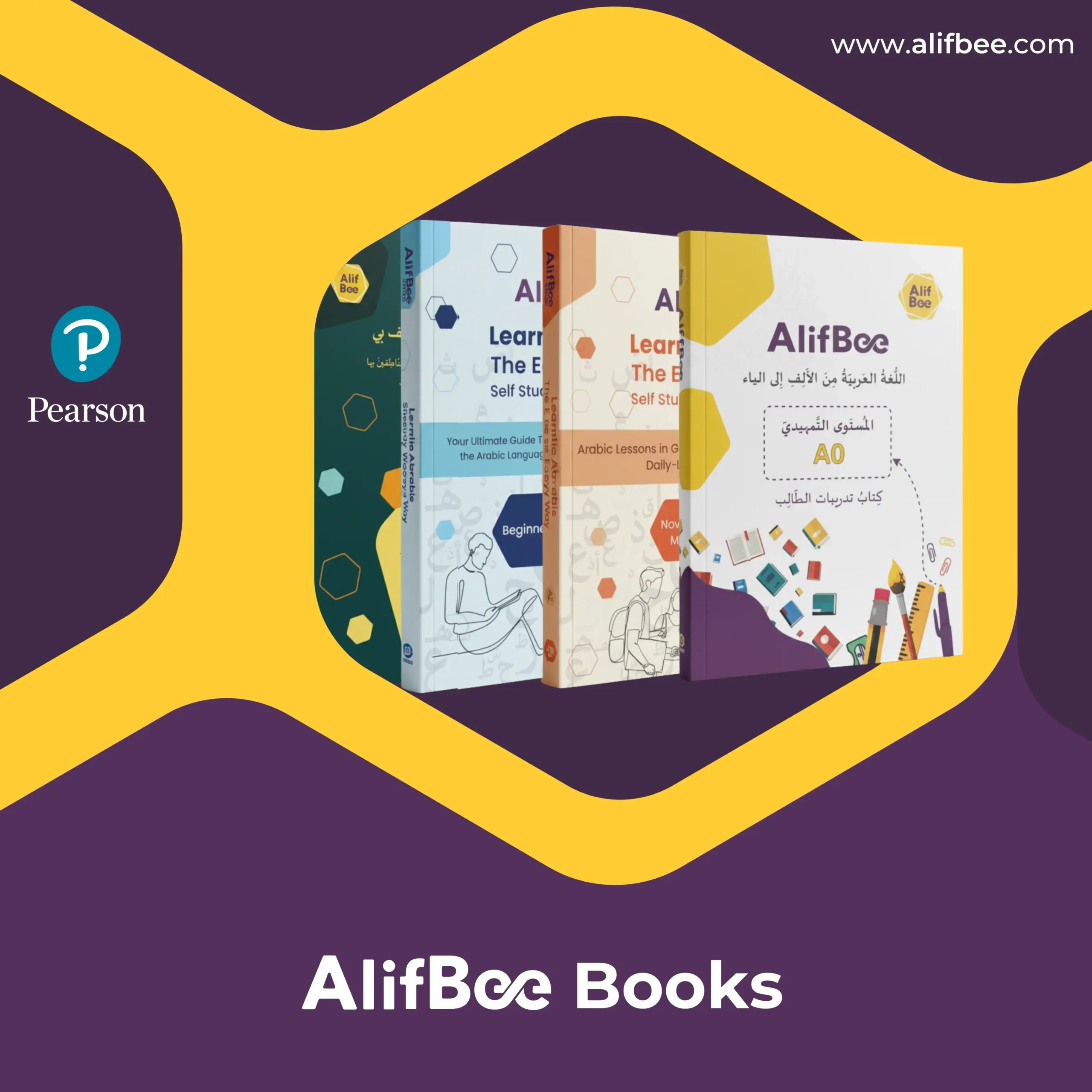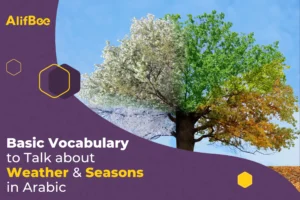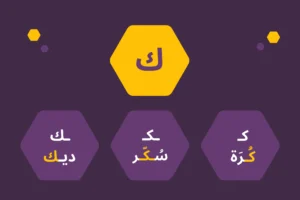Importance of Arabic Language Basics for Beginners
How many times have you met someone excited to start learning a new language, only to find out that they quit a couple of weeks later? It’s more common than you think. Now imagine that this language is Arabic: a unique script and sounds that are worlds away from English.
To many, learning Arabic basics brings excitement mixed with lots of confusion, maybe even a touch of overwhelm. As a result, many new learners hesitate, unsure where to start or worried it’s just too hard.
But here’s the secret: Arabic is accessible, and you’re already on the right path just by being here!
In this beginner’s roadmap, we’ll change that overwhelm into excitement by focusing on Arabic basics, or the essentials of learning Arabic. Think of this as your trusty guidebook, complete with clear steps and links to deeper resources from AlifBee to help you dive further into each topic.
Ready to start your Arabic journey?
The 10 Must-Know Arabic Basics
To make things more relatable, we’d like to think of learning Arabic for beginners as decoding an ancient map. And there are 10 essential keys that will help you understand it so you can finally reach the treasure.
1. The Arabic Alphabet
This is the foundation of your learning journey and the key that unlocks reading, writing, and deeper understanding of the language. Mastering the Arabic alphabet opens up signs, books, songs, and conversations, so learning it is a must for any serious learner.
Yet, it’s also one of the biggest challenges when learning Arabic. The Arabic alphabet has 28 letters, written right to left, and many letters are shape-shifters. In other words, they change form depending on their position in a word—beginning, middle, or end.
And it doesn’t stop here. Some letters connect to others, while a few stand alone.
This flexibility gives Arabic its beautiful, flowing script, but it can also feel quite overwhelming. Let’s take a closer look and see how letters look different depending on their position within the word.
Letter
Isolated
Initial
Medial
Final
Pronunciation
Example
أ
أ
أ
ـأ
ـأ
alif (a)
أَب (ab, father)
ب
ب
بـ
ـبـ
ـب
ba
بَيت (bayt, house)
ت
ت
تـ
ـتـ
ـت
ta
تَاج (tāj, crown)
ج
ج
جـ
ـجـ
ـج
jeem
جَمَل (jamal, camel)
د
د
د
ـد
ـد
dal
دَرْب (darb, path)
ر
ر
ر
ـر
ـر
dal
رَمْل (raml, sand)
But hey, we’ve got you. Our Arabic Alphabet Series focuses on explaining how every letter is written and pronounced with examples that clear up any confusion. Thanks to AlfBee’s tips, the alphabet won’t be that mysterious.
2. Pronunciation Tips for Speaking Arabic
Ready to sound like a natural when speaking Arabic? Pronunciation is your golden ticket to being understood and connecting with native speakers.
However, the way the letters look isn’t the only challenge. Arabic has sounds that don’t exist in English, such as “ع” (ʿayn), a deep throat sound, “خ” (kha), like the “ch” in German “Bach,” and “ق” (qaf), a strong, back-of-the-throat “k.” These sounds give Arabic its distinctive melody, but they can feel like a vocal adventure at first.
Let’s take a look at this example:
Tip
Meaning
Pronunciation
Arabic
Focus on the “kha” by exhaling sharply, like fogging a mirror with a raspy edge. Say “kha-roof” slowly.
sheep
kharūf
خَرُوف
Try the “ayn” by tightening your throat slightly, like saying “in” with a deep hum. Practice “ʿi-nab.”
grapes
ʿinab
عِنَب
Push the “kaaf from the back of your throat, like a strong “k.” Say “qa-mar” with confidence.
moon
qamar
قَمَر
AlifBee’s app is packed with audio feedback tools and pronunciation games that make learning fun. Record yourself saying “خَرُوف” (kharūf) and compare it to native speakers in real-time. AlifBee’s interactive lessons break down each sound with clear examples, helping you perfect “ع” or “ق” without stress.
You can also build your confidence with the Noorani Qaida. This is a method that speeds up learning Arabic by allowing you to break down every sound and letter. By simplifying Arabic phonetics, learning the language can become easier for non-native speakers.
3. Common Arabic Words and Phrases for Everyday Use
While learning traditional Arabic can be extremely rewarding, many learners just want to be able to order their “shay” (tea) or thank the waiter with a cheerful “shukran” (thank you), all while sounding like a native.
For beginners, learning common Arabic words and phrases grants access to real-world conversations and makes you feel like a language superhero from day one. These high-frequency words are your ticket to chatting, shopping, or traveling with ease.
Basic Arabic words and phrases are the building blocks of communication. They give you the power to jump into conversations without needing to know the whole language. These words are practical, versatile, and used everywhere—from markets to casual chats. Words like “marhaba” (hello) or “ma’a as-salama” (goodbye) let you connect with people instantly.
Ideally, you can start with 5–10 words a week, focusing on themes like greetings, food, or travel. AlifBee’s most common Arabic words, most common Arabic verbs, and most common Arabic adjectives will give you that instant push.
4. Reading and Writing Arabic
Now, let’s ask a question: Do you really need to learn to write Arabic to speak it?
As a beginner Arabic learner, speaking Arabic is the star of the show at the start, and that’s totally fine. Reading and writing might feel like the extras you’re not quite ready for, especially when you’re focused on nailing pronunciation.
But here’s the exciting twist: adding reading and writing to your Arabic adventure is like unlocking a secret level in a game—it supercharges your skills and opens up a whole new world of possibilities.
When you’re just starting out, speaking is the flashy, instant-gratification part of learning Arabic. You want to order shawarma or greet a friend, not wrestle with the cursive script that looks like prehistoric writing.
It’s natural to prioritize chatting over decoding letters or scribbling words, especially when the Arabic alphabet feels like a puzzle. But don’t skip reading and writing for too long—they’re about to become your best friends!
Writing and reading are like a power-up for your journey learning Arabic. Writing even short words, like “كِتَاب” (kitāb, book), helps cement vocabulary in your brain through active recall, so you can easily remember words during conversations.
Reading helps you learn Arabic grammar by showing you how sentences flow, like when you see the pattern in “أَنا أُحِبُّ” (ana uḥibb, I love). Also, writing letters like “ب” (ba) or “م” (meem) helps you learn how to connect shapes to sounds, which makes your pronunciation better. Every word you write or read is a small win that makes you feel like a superstar in Arabic.
Gradually, you’ll confidently read a menu to order “فِلْفِل” (filfil, pepper) or a street sign to find the “السُّوق” (as-sūq, market). These skills let you dive into Arabic books, browse social media posts, or even write professional emails for work.
We understand that reading the right-to-left script is pretty challenging. This is why AlifBee’s Story Series on Kotobee are designed for adult learners from A1 to B2 (beginner to intermediate). These digital stories offer a structured, engaging way to practice reading Arabic. With leveled content, clear vocabulary, and interactive elements, they make reading feel like diving into a good book rather than a chore.
Then, you can hone your writing skills with AlifBee’s Workbook Series. These workbooks guide you through tracing letters, writing words like “قَلَم” (qalam, pen), and forming simple sentences. They’re perfect for beginners, with exercises that feel like a game rather than homework.
5. Common Greetings and Expressions
You’re walking into a lively Arabic café, flashing a warm smile, and saying “Marhaba!” to instantly connect with everyone around you. Sounds fun, right? And the best part is that it’s possible.
Arabic greetings are the secret handshake of the language—they’re culturally and socially essential. For beginners, mastering these greetings opens the door to confident conversations and deep cultural connections. But which one should you choose?
Using the right greeting shows you value the culture, making people light up when they hear you speak Arabic. Plus, they’re easy to learn and give you instant confidence to start conversations!
Here are some examples:
Cultural Context
Meaning
Pronunciation
Greeting
Casual, warm; great for welcoming friends or guests, often used in hospitality settings.
Welcome
ahlan wa sahlan
أَهلاً وَسَهلاً
Formal, religious; used in most settings, especially with new people or in respectful situations.
Peace be upon you
as-salamu alaikum
السَّلامُ عَلَيكُم
Casual; perfect for everyday chats with peers or in informal settings like shops or cafés.
Hello
marhaba
مَرحَباً
Arabic greetings vary by formality and context, so knowing when to use each one is key. Special Arabic greetings for Ramadan or celebrating Eid make you instantly connect with the locals who value your interest in the Arabic culture.
Are you ready to win hearts with these greetings? Download the AlifBee app to practice the most common greetings with interactive audio lessons, and check out the linked blog posts to dive deeper. Your Arabic adventure just got a lot friendlier!
6. Arabic Numbers
Fun fact: The numbers used in Arabic originated in India. Nevertheless, it was the Arab mathematicians who worked with them and incorporated them into various scientific fields.
As a beginner Arabic learner, learning how to read, write, and say the Arabic numbers will be a crucial part of your experience. Without doing so, you won’t be able to haggle that scarf you liked in the market, pay your check at the restaurant, or understand a local telling you that the bus arrives at seven.
Beyond prices and time, numbers are essential in phone calls, transactions, and travel. Picture yourself giving a taxi driver your destination, “arbaʿa” (four) or sharing your phone number with a new friend. Numbers make these moments smooth and empowering, helping you explore life like a local. They’re high-frequency tools that build your Arabic momentum fast.
To master Arabic numbers fast, start by memorizing 0–10 with AlifBee’s interactive lessons or flashcards, pairing each number with its pronunciation (like “wahid” for one). Practice in real-life scenarios—count items at home or say prices aloud while shopping.
7. Basic Arabic Grammar and Sentence Structure
Wouldn’t it feel great if you could confidently say “Ana uḥibb al-khubz” (I love bread) to a baker in a bustling souk, or ask “Mā hādhā?” (What is this?) while pointing at a shiny trinket?
Basic Arabic grammar is the glue that holds your words together, letting you build sentences that make sense. It’s like learning the basic steps of a dance—once you know the rhythm, you can move freely!
With AlifBee, we keep it light, practical, and fun by focusing on just enough structure to get you chatting like a pro. Let’s explore the essentials of Arabic grammar with easy tips and AlifBee’s resources to make your sentences shine!
Here are some basics you can easily master:
Subject–Verb–Object (SVO) Word Order
Arabic often follows a subject–verb–object order, similar to English, making it easy to start forming sentences. For example, “أَنا آكُلُ تُفَّاحَةً” (ana ākul tuffāḥa, I eat an apple) has the subject (ana, I), verb (ākul, eat), and object (tuffāḥa, apple).
Negation
To say “not,” use “لا” (lā) before the verb in simple sentences. For example, “أَنا لَا آكُلُ” (ana lā ākul, I don’t eat) flips a positive sentence to negative.
Simple Connectors
Words like “وَ” (wa, and) or “أَو” (aw, or) link ideas together. For instance, “أَنا أُحِبُّ الخُبزَ وَالشَّايَ” (ana uḥibb al-khubz wa ash-shay, I love bread and tea) connects two nouns smoothly.
8. Masculine and Feminine Words
When learning Arabic basics and Arabic grammar, understanding masculine and feminine words is like getting a secret code to make your Arabic sentences sound natural and respectful. Gender shapes vocabulary, verbs, adjectives, and even greetings, which makes it one of the first things to grasp as a beginner.
Don’t worry, it’s not as tricky as it sounds! With simple patterns and a bit of practice, you’ll be adapting words like a pro.
Unlike English, in Arabic, gender affects how you build sentences, from describing someone as “jameel” (handsome, masculine) or “jameela” (beautiful, feminine) to using the right verb forms or greetings. It’s a core grammar rule that adds precision and cultural respect to your words.
Spotting Arabic gender is easier than you think with a few key clues:
Feminine Marker
Many feminine nouns end in “ة” (pronounced -a, called tā’ marbūṭa). For example, “madrasa” (school) is feminine, while “bāb” (door) is masculine without the “ة”.
Adjectives and Verbs
Adjectives in Arabic match the noun’s gender, so “kitāb jadeed” (new book, masculine) becomes “sayyāra jadeeda” (new car, feminine). Verbs and greetings also adjust, like saying “Anti tāliba” (You are a student, feminine) versus “Anta tālib” (You are a student, masculine).
Start by learning a few common nouns with their genders, like “qalam” (pen, masculine) and “kursiyya” (chair, feminine). Practice matching adjectives, like “kabīr” (big, masculine) and “kabīra” (big, feminine), in simple sentences. Use AlifBee’s vocab games to drill gender pairs, and try role-playing scenarios, like describing objects or people, to make it fun.
AlifBee’s resources explore gender rules with clear examples, showing how they shape nouns, verbs, and more. For extra help with adjectives, our Arabic Adjectives for Beginners guide explains how to match adjectives to masculine and feminine nouns, like “saʿīd” (happy, masculine) and “saʿīda” (happy, feminine).
9. MSA vs. Arabic Dialects
Arabic learners often hear about MSA and Arabic dialects and wonder why there’s a split between written and spoken Arabic. MSA is the formal, standardized version used in writing, media, and official settings across the Arab world, while dialects vary by region—like Egyptian, Levantine, or Gulf—and are used in daily conversations. Such big differences don’t exist in other languages like English and French.
For beginners, learning Arabic should start with MSA as their bedrock. It’s the language used in books, news, formal speeches, and even dubbed cartoons, making it understandable everywhere. It’s the “official” Arabic that connects all Arabic speakers, perfect for reading, writing, or speaking in professional or educational settings. Regardless of their region, locals will understand MSA, and starting with MSA gives you a solid base to understand any Arabic context.
Dialects are the lively, local versions of Arabic you’ll hear in casual settings, like when chatting with friends or watching regional TV shows. They are less formal, full of slang, and vary by region, but they’re what makes conversations feel authentic and fun. Some words would have a meaning in one dialect and a totally different one in another.
Here is an example of the variation in a basic Arabic Greeting:
How are you?
MSA: كَيفَ حَالُكَ؟ (pronounced: kayf haluk?, meaning: How are you?) – Formal, used in writing or official settings.
Egyptian Dialect: إزَّيَّك؟ (pronounced: izzayyak?, meaning: How are you?) – Casual, perfect for chatting with friends in Cairo.
Levantine Dialect: كِيفَك؟ (pronounced: kifak?, meaning: How are you?) – Relaxed, used in Amman or Beirut.
Instead of feeling overwhelmed, think of MSA and dialects as two sides of the same coin—both are part of the Arabic adventure! Start with MSA to build a strong foundation, then explore a dialect that matches your goals, like Egyptian for movies or Gulf for business in Dubai.
Choosing the right Arabic dialect depends on your interests, whether you want to travel, enjoy the media, chat with the locals, or master Arabic for business purposes.
10. Arabic Proverbs and Arabic Culture
Proverbs represent the heart and soul of languages, but with Arabic, they go a little bit further. Unlike many cultures, Arabic speakers use plenty of proverbs in their daily lives. You can see them printed in shops or decorating trays in cafés. This is why learning proverbs opens doors to better understanding the language and the people behind it.
Arabic reflects a culture rooted in community, resilience, and wit. Arabic proverbs are a perfect example, blending everyday words with deep meaning and values like patience, generosity, courage, or trust.
For instance, saying “مَنْ جَدَّ وَجَدَ” (whoever strives, finds) teaches both the verb “to strive” and the cultural emphasis on hard work.
Picking up a handful of proverbs gives you a richer understanding of how Arabic speakers share wisdom and emotion. These sayings help you bond with native speakers and feel like part of the conversation. Plus, memorizing short, catchy proverbs is a fun way to see quick progress and feel like an Arabic rockstar!
Start with one or two Arabic proverbs, practicing their pronunciation and meaning with AlifBee’s Arabic proverbs. Use them in role-plays, like giving advice to a friend, to make them stick. Write them down to reinforce vocab, and try spotting them in Arabic shows or conversations. Their cultural context will have you grinning at the cleverness of Arabic wisdom.
Beginner Arabic Tips to Build Your Learning Habit
After you have gone through our special roadmap of Arabic basics to start learning Arabic, you should remember that building a consistent Arabic learning habit is like planting a seed: it starts small but grows into something amazing with a little care each day. These practical tips will make Arabic learning a breeze, and AlifBee’s tools will keep you on track like a trusty guide.
- Practice 10 minutes daily with the AlifBee app for quick, interactive lessons on vocab, pronunciation, or grammar, like practicing “shukran” (thank you) or tracing the letter “ب” (ba).
- Speak out and practice saying basic Arabic words and phrases like “Kayf haluk?” (How are you?) to get comfortable with Arabic’s unique sounds. Try role-playing scenarios, like ordering coffee or greeting a friend.
- Track your vocabulary using a journal to jot down new words or track them in the AlifBee app, which organizes your progress like a digital scrapbook. Review a few words daily, and watch your vocab grow.
- Focus on understanding patterns, not just memorization. Arabic is full of patterns, like the “ة” (tā’ marbūṭa) for feminine nouns or the “k-t-b” root for writing-related words. Instead of rote memorizing, spot these patterns to make learning easier.
Final Word
Now, you are all set to start your epic Arabic learning adventure. You can say “Marhaba!” or write your first “كِتَاب” (book) like a language explorer. It’s normal to feel both excited and nervous. Every Arabic learner starts where you are.
You can start talking, reading, and connecting in Arabic in no time if you have the right tools and spend just 10 minutes a day. AlifBee is your reliable guide, giving you everything you need to make this trip enjoyable and worthwhile.
Are you ready to jump in? Get the AlifBee app from your app store today and start with fun lessons that make learning Arabic feel like a game. You can practice saying “خَمسَة” (khamsa, five) or “السَّلامُ عَلَيكُم” (as-salamu alaikum, peace be upon you). To start learning Arabic today, check out the linked blog posts on AlifBee’s Blog for more in-depth information. You’re just starting your journey into Arabic, and every step is a chance to discover a rich world of language and culture.









